.
Griechische Waffentechnologie: Kriegsschiffe
Part 1
It is true thou wretch, that we have left behind us our houses and our city walls, not deeming it meet for the sake of such lifeless things to being subjection; but we still have a city, the greatest in Hellas, our two hundred triremes. Themistocles before the Greek navy sailed to Salamis according to Plutarch
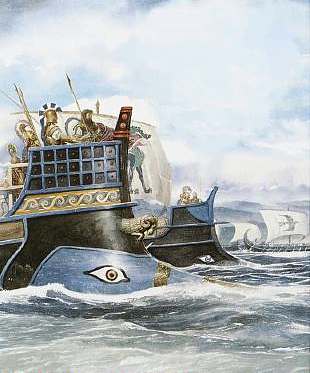
Rosemary Sutcliff, Black Ships before Troy, Illustrated by Alan Lee
Homer describes in the second book of the Iliad how 1186 Greek ships were used for the transport of the Greek army to Troy or Ilios which was probably derived from Wilusa. The reason for this expedition was not the beautiful Helena but probably to obtain the control of the passage to the black sea from Troy (a city that now is known as Troy VIIa and which was destroyed by the Greeks in 1180 BC ) . Among the ships Homer describes that each of the 50 Boetian Ships carried 120 warriors. The ships were probably covered by a black paint (probably pitch for the protection of the wood) and had a single sail. When the Greek Ships arrived in Troy they were drawn on land and were surrounded by a wall for their protection, a procedure used later as described also by Julius Caesar. The anchor was a simple heavy stone. Homer describes how Odysseus built his own Ship by cutting 20 trees. Navigation at that time was probably mostly limited close to the land and not on the open sea without sight of the land.
Helen, the face that launched a thousand ships
Before the invention of the trireme the standard warship was a single-banked ship with a crew of 50 rowers (25 a side), called a pentekonter(Pentèkontoros probably introduced by the Phoceans) and also the triakonter (Triakontoros) with 30 rowers. With a distance of around 1 m between the rowers the length of the pentekonter was around 30 m. There is a need for more rowers but estimates show that the ship length was close to the critical length of 35 m that was possible by the materials and technology used. The width of the ship was around 4m. Two versions were used were the undecked open vessels (afrakta) and the vessels with a deck (katafrakta). The rowers were actually warriors and the ship was used for troop transport (like that to Troy). The pentekonter were called makra, i.e. long ships whereas previously the vessels were stroggula, i.e. round.
To increase momentum meant more rowers, to reduce extra size and weight meant putting oars and oarsmen over one another. This leads to the bireme (or dieres) (probably introduced by the Erythraeans). This raises the centre of gravity and threatens the stability of a very low-draughted ship. The ingenious solution has only recently been explained and proved. The large number of rowers needs also a synchronization and thus a special training and this changed also the war tactics as the rowers were not professional warriors. It seems strange to reduce the number of warriors but the bireme and trireme were faster than the pentekonter and with their ram (a bronze tipped projection from the bow (front) of the ship) it was much easier to destroy a pentekonter even if it had much more warriors. An obtused-prowed bireme version was produced in Samos during the period of Polycrates. The name of the first ship of this type was Samaina (or Samaena) that could be used as a trading or as a warship (Athenaeus, Deipnosophistae and Plutarch Pericles).
697 BC. The Corinthians begin first of any men to build ships with three orders of oars, called Triremes. Hitherto the Greeks had used long vessels of fifty oars. Sir Isaac Newton, A short chronicle: From the First Memory of things in Europe to the Conquest of Persia by Alexander the Great
It was the Greek trireme (or trieres in Greek), with three tiers of rowers, that proved to be the defining weapon of the battle of Salamis in 480 BC. The invention of the trireme could be around 700 BC by Ameinocles the Corinthian, who made the Samians acquainted with it (Thucyd. i.13; Plin.H.N.vii.57); Ameinocles constructed the Trireme (Olympias ,***) for the Athenians (640 BC). The triremes could move fast under sail, reaching a maximum of perhaps 14 knots under the most favourable weather conditions (some consider 10 knots more realistic). The speed without sail was probably around 8 knots. The speed of the ship depends on the length, shape, weight, on the physical condition of the rowers and various physics phenomena (friction, wave drag, etc). Experts say that even without knowledge of hydrodynamics the ancient Greeks optimized the trireme such that it was the fastest ship in antiquity. The Trireme was as experts estimate 30% faster than a Pentekonter.
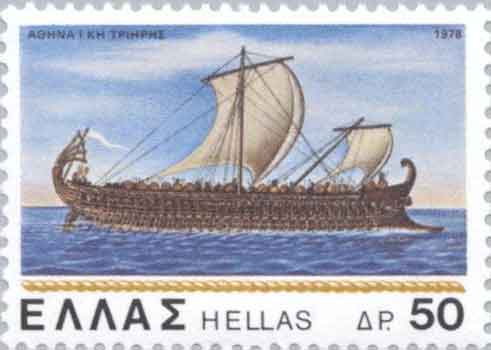
Greek Stamp Athenian Trireme (the “spear ship” according to Aeschylus)
It was Themistocles who proposed to build a fleet of triremes. He also carried a decree, that every year twenty new Triremes should be built paid by the silver of the mines of Laurium. After the time of Themistocles as many as twenty Triremes have been built every year as the vessels of a light structure did not last long. The whole superintendence of the building of new Triremes was in the hands of the senate of the Five Hundred (Demosth. c. Androt. p598), but the actual business was entrusted to a committee called the trihropoioi.
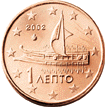
The Greek 1 Cent Euro coin with a trireme (Designer: Ms A.Michelioudaki)
According to Stephan Schulz "...around 800 BC, the ram was developed as a ship-to-ship weapon. Suddenly, speed and maneuverability became prime concerns.
F.H. van Dorninck, Jr., "Protogeometric longships and the introduction of the ram," IJNA 11.4 (1982) 277-86 (PDF File) (suggests that the Ram was maybe used 100 years earlier)
...The trireme was probably the most formidable ship ever designed for fighting with a ram." Functioning similarly to a modern frigate, the trireme represented the best that naval technology has to offer at that time, one of the most dangerous and effective weapons. The Greeks used the ram to punch a hole in an enemy ship below the waterline and sink it. This tactic was known as diekplous. The trireme when dressed for battle was nothing else but a stripped-down water-borne projectile, propelled by human muscle power.
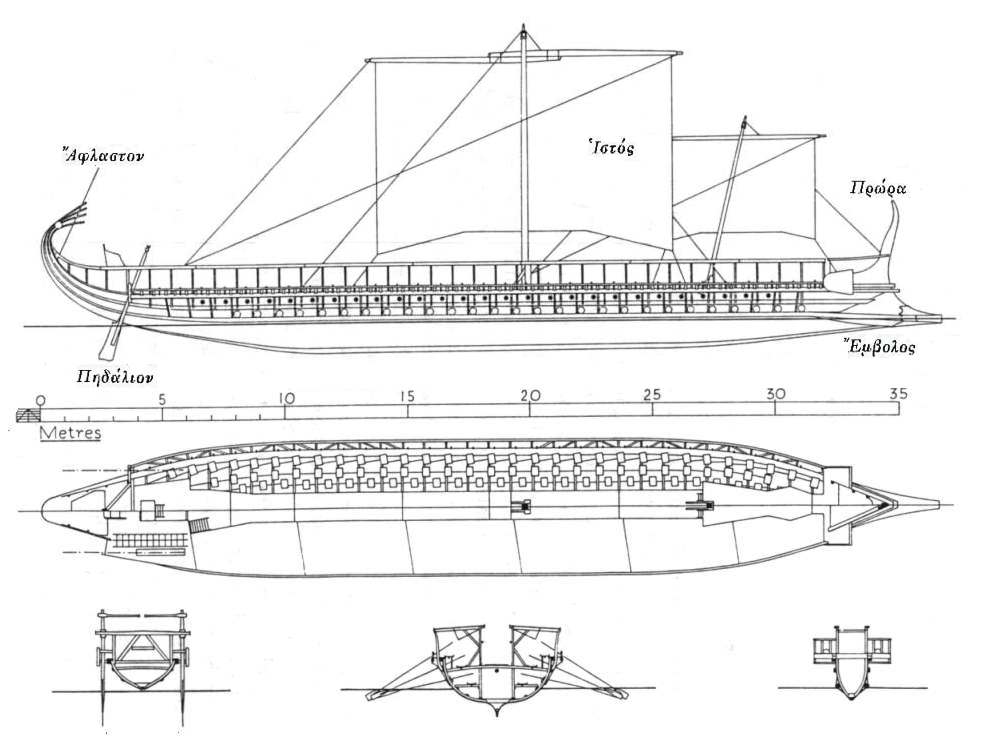
possible plan of a Trireme. A tall mast and a smaller close to the front of the ship..
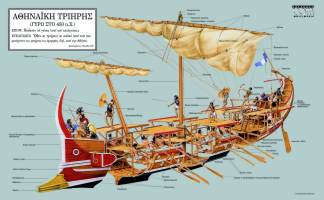
Trireme Poster (2445 x 1511 Pixels, c. 650 KB)
- Overall length: around 37 m (121 feet)
- Overall beam: 5.5 m (18 feet)
- 170-174 oarsmen in 3 files on each side: top file 31, middle and bottom 27- 29
- Oarsmen spaced at 2 cubits (0.888 m/2 feet 9 inches)
- One man per oar
- Oar length 4.2m (13 feet 8”) and 4.0m (13 feet) - short oars at ends of ship
- Speed: able to cover 184 sea miles at about 7.5 knots without stopping (Athens to Mytilini according to Thucydides)
- Weight (45 tons according to a report for the Olympias a modern trireme reconstruction)
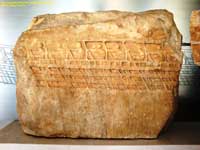
Trireme Relief
A stone relief found in the Acropolis of Athens showing a trireme crew. The images analyzed and according to a Scientific American publication revealed that the crew used a technique that was discovered again only in the 19th century by athletes in rower contests. A 0.55m x 0.4 m marble relief found by the archaeologist Lenormant. Probably it shows the Trireme Paralos in the 4th century BC. 7 of 31 (on one side) Thranite rowers are shown (here we see only a part of the relief) . The rowers probably used a cushion (hupêresion).

The two reliefs from the Acropolis and from Pozzo combined produce a more complete image
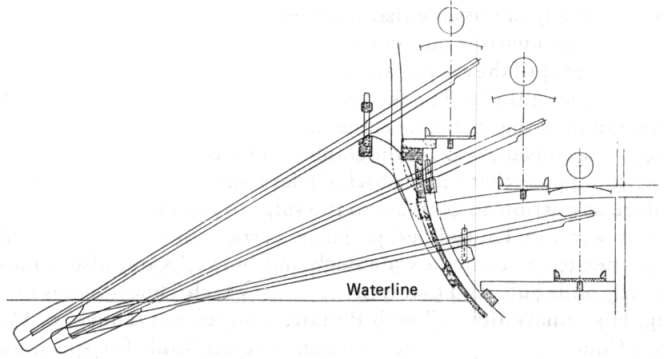
An image of the crew of the Olympias reconstruction .... and of the Helmsman Another view in Color
Versions, with a modified deck, were build for the transport of warriors (oplitagagos) or horses (ippagagos). The rowing port-holes were protected by leather bags (askômata), that prevented sea water to enter in the ship in a rough sea.
No ancient ship-building manuals nor sailing directions have survived. Before 1971, when the earliest identifiable warship (3rdC BC Carthaginian) was found off NW Sicily, details of design and manning (particularly the placement of rowers in a trireme) were guesswork, based largely on surviving representations of ships on stone reliefs, vase-paintings,etc. Both fighting ships and cargo vessels had oars + sails for propulsion. The trireme had a large square sail. When not stripped for battle, she cruised with a full spread of canvas, but when preparing for action she left all her gear, including the sail, ashore. For obvious economic reasons, oared cargo vessels were rare, since crews of rowers occupy space at the expense of cargo.
The trireme was built for speed and mobility. They were built low to the ground, the bottom row of rowers were just 18 inches above the waterline, and very narrow which meant that the triremes were not built to handle open ocean. The rough seas would make short work of a trireme because of its very low weight. The triremes were built for short, close in, battles. They were not made to handle long, open ocean campaigns. However, the triremes were very fast and maneuverable which gave them a critical advantage in the close-in battles that were typical of ancient naval engagements.
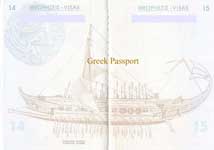
Greek Passport: , Trireme,
Casson : The Age of the Trireme (PDF)
(***) ( According to a Greek Website / URL information lost )
| Ancient Greece
Science, Technology , Medicine , Warfare, , Biographies , Life , Cities/Places/Maps , Arts , Literature , Philosophy ,Olympics, Mythology , History , Images Medieval Greece / Byzantine Empire Science, Technology, Arts, , Warfare , Literature, Biographies, Icons, History Modern Greece Cities, Islands, Regions, Fauna/Flora ,Biographies , History , Warfare, Science/Technology, Literature, Music , Arts , Film/Actors , Sport , Fashion --- |

